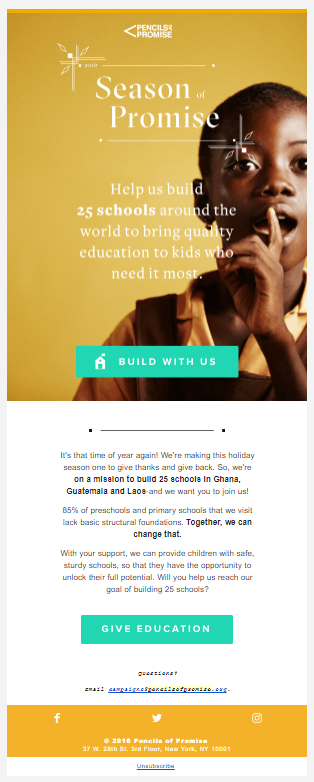Today, businesses are driven by relationships and the most important one is that with your customers. Once you develop a connection with them it is the initiation of a relationship that you need to nurture on a regular basis. Email marketing is a fantastic tool, which can do both- develop a relationship and nurture it.
You might question, “We are a nonprofit organization. Will email marketing work for us?” Your organization is making a difference in someone’s life and profit is not your motive. Certainly, email marketing can help your organization to connect with people who can make a considerable contribution to your cause as email marketing is not meant only for profit-making organizations.
Email marketing for nonprofits means spreading awareness about your cause, objectives, and vision.
It’s about making people realize that their contribution can improve living conditions for an individual and a community too.
It can add donors to your existing list, create a loyal donor base and increase donations.
So, let’s prepare a nonprofit’s guide to email marketing to kickstart your campaign:
1. Creating a loyal customer base
There are various ways of creating a loyal customer base. There might be an event that you’ve hosted and people have shared their details along with their email ids at the kiosk. You can email them and remind them about attending the event. You can share your objective and cause along with a convincing note about how they can contribute to the cause.
When someone visits your organization’s website, they will look for your email list signup form. So, let it be visible and easy to find. Like it can be in the footer where you have your “about us” or social media information. The best is the pop-up form on your website, which makes it easier for the visitor to sign up.
2. You made a difference
When people make a contribution or donation, they ought to be told that they’ve made a difference in society. Run them through all the activities that get a boost due to the donation. Tell them who benefitted from it and how it has changed things for that person or community. For example, if your cause is providing education to the needy, send them photos of the children who managed to go to school due to their donation. Let them know that it enabled a child to pay school fees and that the child could buy books and other things needed to study.
You can also inform a further donation can help the child’s education for the next year too. This creates an impact as the donor witnesses in real terms how his/her contribution has changed someone’s life forever.
It can motivate the donor to continue donating. The best way to keep building a loyal customer base is to tell the existing donors how they made a difference.
“The day you sign a client is the day you start losing one.” – Don Draper
Your job starts after someone makes a donation. So, your focus shouldn’t be acquisition but, retention.
3. Information and updates
Your organization conducts awareness campaigns and programs. Keep your existing email subscribers informed about them. Let them know about what work you do and your achievements. Share with them the experiences of people who benefit from your work.
Include in your newsletter interviews of your team, donors, and people who receive help from you. It will encompass the entire affairs of the organization that works towards a cause to which your audiences emotionally connect.
If you are planning to launch a new campaign, make the biggest impact by reaching specifically to those supporters in your list who have shown interest in this type of campaign previously. You can also make the audiences aware of how important the cause is to the nation and society. All this information can be shared regularly through newsletters.

4. Automated emails
The team members of non-profit organizations are busy handling donations, campaigns, promotions, visits to the needy people and changing society. They are left with little time to keep engaging the audiences. But, automated emails help the team to be continuously in touch with the audiences- new and existing. Automated emails save a lot of your time.
You can send welcome, thank you and retention emails through automation. When someone signs up your email list or donates for the first time it’s the perfect time to send an automated series of welcome emails.
Introduce your cause, work and how the audiences can contribute or get involved. Welcome emails get high open rates and you can expect an amplified engagement.
Also, thank you emails are automated and it sets the ball rolling for the follow-up emails that show the result of the giving in a month. Once you have determined the ways you wish to communicate with the segmented audience, it’s simple to prepare a series of automated email journeys for them.

5. Imagery and content
Whenever you approach someone for a cause its necessary that you develop an emotional connection. The new and even the existing donors will donate or have donated because they feel an emotional connect with the cause.
Thus, your language should be emotionally appealing and move the audience to get interested in the cause and further donate/ contribute or spread the word.
All the images that you use, though professional, should appeal to the emotional side of the audiences. They should develop a deep and lasting bond with the audiences.

Other things that we need to understand, which are common for all email campaigns are:
Keep a tab on the performance of your campaigns – open rate, conversions, click-through rates, and list of people who unsubscribed. Once you figure out the reasons behind the success and failure of your email campaigns you can keep improving on them to increase the engagement.
Without a doubt, your emails should be personalized based on the responses of the audiences. Emails should be sent to people based on their interest and inclination.
Besides sending welcome and thank you emails, you can invite them to your events, ask them to participate so that donors know about your work and are encouraged to help more. Send them weekly newsletters to update them about recent donations, most successful events, etc.
You can also send retention emails that show your donors the impact that their donation has made on the lives of the receivers and will inspire them to stay involved. It is vital that you segment this list based on their past donations.
Juvlon is here to guide and assist you through the email campaigns. Get in touch with the Juvlon team to know more.
Keep reading our blog posts as they are a doorway to interesting information from the world of email and SMS marketing.

